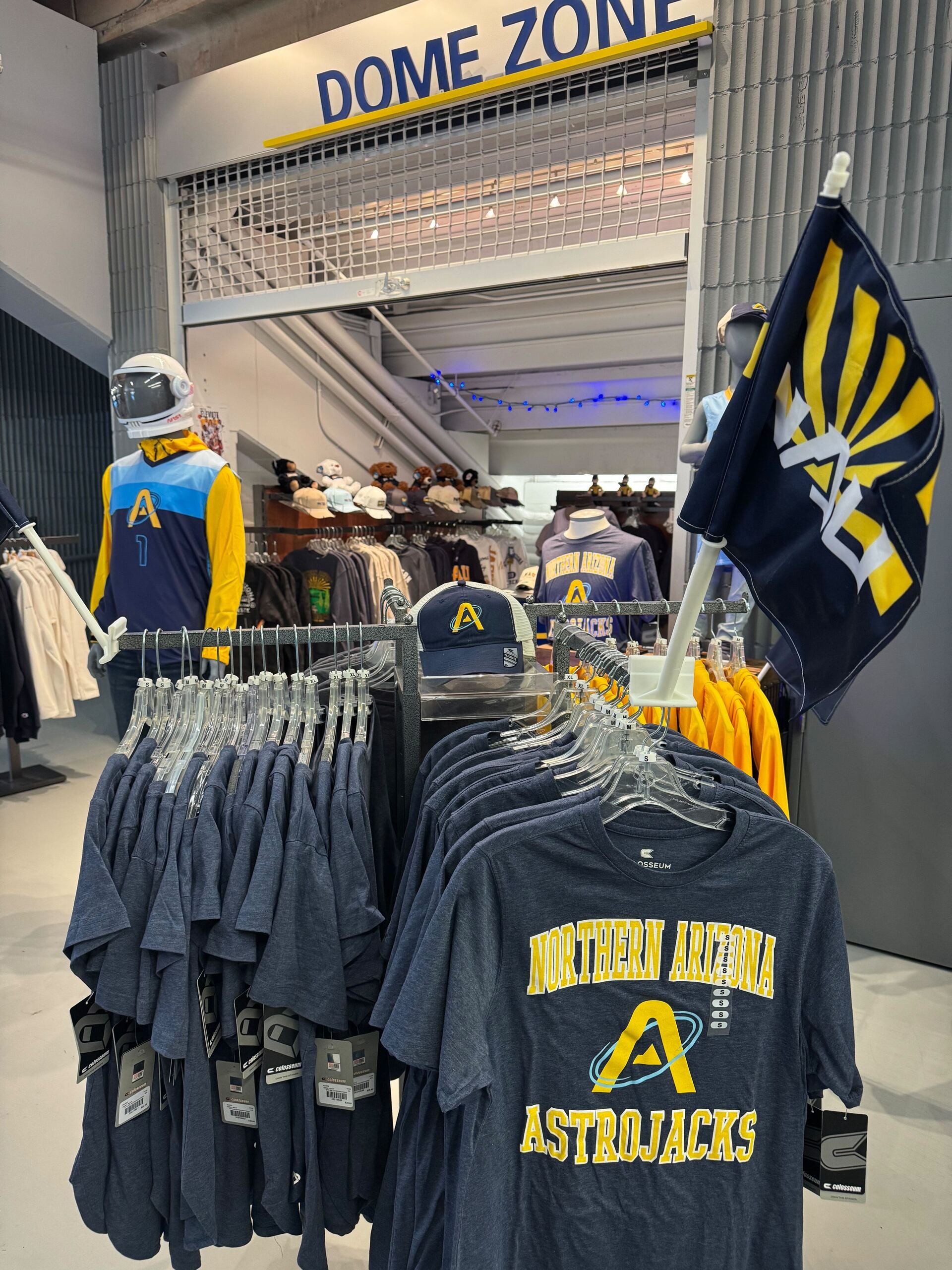Good morning, and thanks for spending part of your day with Extra Points.
We're going to try something a little unique, and go with a unified theme this week. For the next several days, we're going to try to have all of our Extra Points content relate to mid-majors and NCAA tournaments. I'm interviewing mid-major ADs, digging into the history books and archives, talking to experts and more to provide a little more #context and #color to the NCAA tournaments.
Today, I turn the time over to Andy, who tries to answer an important question. What is actually sustainable after a mid-major makes an NCAA tournament run?
For the second year in a row and just the third time ever, a No. 15 seed danced to the Sweet 16 in the NCAA men's basketball tournament, as Saint Peter's knocked off Kentucky and Murray State.
On some level, this might be the most unlikely Cinderella ever. According to Sportico, the difference in the men's basketball budgets of Saint Peter's and Kentucky is the biggest gap ever, even larger than the gap between No. 16 seed UMBC and No. 1 seed Virginia.
Already, rumors are swirling about that Saint Peter's head coach Shaheen Holloway could return to his alma mater, Seton Hall. Kevin Willard, who's expected to leave Seton Hall to take the Maryland job, endorsed such a move. Even if Holloway doesn't take the Seton Hall job, after such a dramatic run, it will be difficult for Saint Peter's to keep him forever.
That begs the question...what, if anything, from this miracle March run can be sustainable for a program like Saint Peter's?
Last March, Matt dove into the Flutie effect and wrote that it can be a boon for a university and its athletic department but that a Cinderella run in March isn't something you can necessarily depend on as part of a long-term department strategy.
After all, MAAC teams don't make the Sweet 16 every year, even really good ones. Before this year, five men's basketball programs in the conference had never won an NCAA tournament game.
But teams like Saint Peter's do sometimes break through. What happens next? Here's what I found
I analyzed every NCAA men's basketball tournament starting in 2010, when Butler made the first of its back-to-back national title game appearances, through the 2021 NCAA Tournament. I identified seven schools that made a Cinderella run at a time when they were considered a mid-major or low-major men's basketball program.
Here's the set of schools and Cinderella runs analyzed for this newsletter:

When I interviewed longtime George Mason administrator Kevin McNamee last year, I asked him about the university's considerations when it jumped from the Colonial Athletic Association to the A-10, years after its men's basketball program made the Final Four as a No. 11 seed in the 2006 NCAA Tournament. He told me, “It was basketball. It was all basketball. It was all men's basketball. It was an opportunity for us to take what we had done in 2006 and then we advanced again in the NCAA tournament (in 2011) and it was all driven by basketball."
Of the seven schools listed above, four have changed, or will soon change, their conference affiliation since making their respective runs in the NCAA men's basketball tournament. Of course, Oral Roberts and UMBC have had less time to make such a change, but the last 15 months or so have also been filled with conference realignment across the Division I landscape. The four schools that have changed or will change conferences — Butler, VCU, Wichita State and Loyola Chicago – each had sustained NCAA tournament success in men's basketball, either through multiple Cinderella runs or one notable run, plus recurring NCAA tournament appearances since then, just like George Mason, which made the NCAA tournament twice in the five years after making the Final Four.
Is this something of a limited sample size? Sure.
But each of those four programs proved it was more than a one-hit wonder and changed conferences soon after.
So, can you base a long-term strategy or marketing campaign around *one* NCAA tournament run?
In a 29-page, five-year strategic plan that was created by Florida Gulf Coast's athletic department in 2016 and revised in August 2020, and later obtained by Extra Points through a public records request, there were four mentions of “Dunk City” or the men’s basketball program’s high-flying Sweet 16 run in 2013.
As part of Florida Gulf Coast’s SWOT analysis, the first bullet point listed among opportunities that would enhance the athletic department was “Continue to embrace Sweet 16/'Dunk City' tradition."
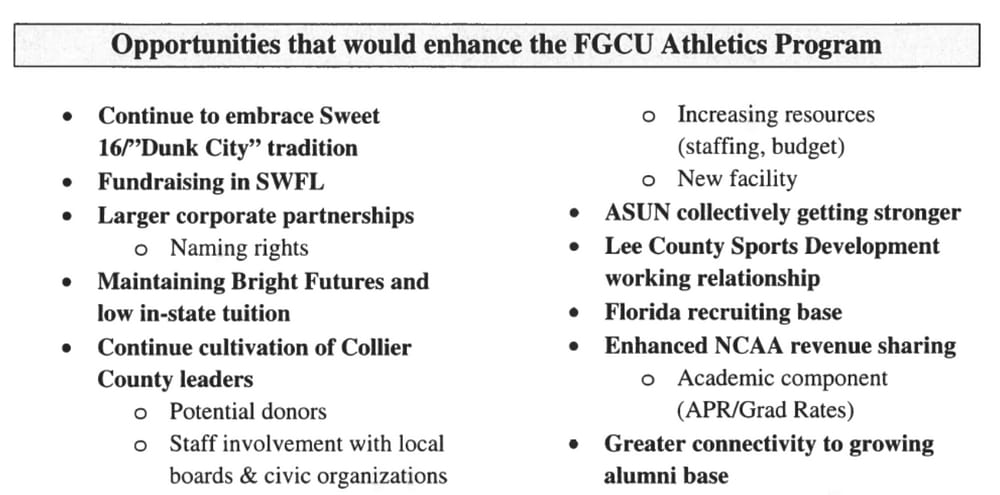
The school’s "Dunk City" moniker was also the third factor listed among what makes the athletic department unique, behind “relative youth” and “location.”
In case you need a refresher on Florida Gulf Coast’s jealousy-inducing and quite literal location…
That is something the university can continue to embrace more easily than an unprecedented run as the first-ever No. 15 seed to advance to the Sweet 16. After all, Florida Gulf Coast's only NCAA tournament win since then came in the First Four in 2016.
Below is a table of each of the seven Cinderella programs' annual, pre-NCAA tournament rankings on kenpom.com, with each program's Cinderella season(s) highlighted in yellow and double vertical lines signifying a head coaching change at the school. Each school's four-year, rolling average for its pre-NCAA tournament rankings on kenpom.com is listed in the row below.
While Butler appeared to capitalize upon an era in which it had its very best teams, the rolling averages for Florida Gulf Coast, UMBC, VCU and Wichita State each peaked in the next few years following their respective Cinderella runs. It's too early to tell what Oral Roberts' trajectory will be after its own Sweet 16 run as a No. 15 seed last year.
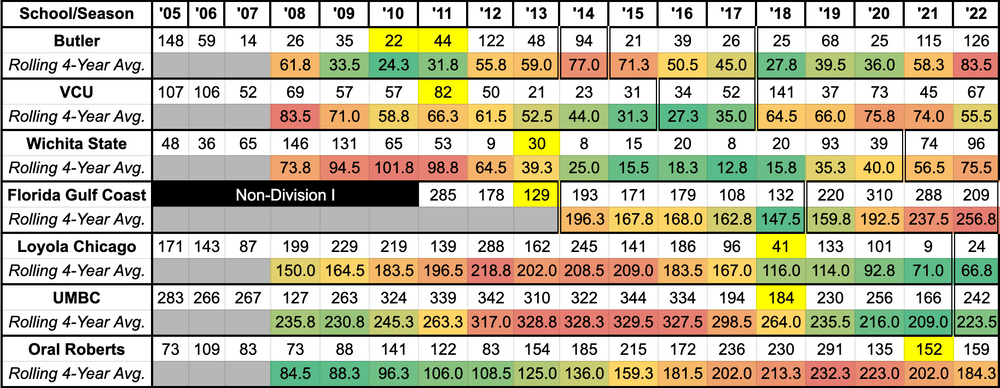
Saint Peter's, the latest Cinderella, finished tied for the worst record in the MAAC in 2019, earning the No. 9 seed in the conference tournament, just as it did in 2018. The Peacocks finished in last place in 2013. Now, on the other hand, they finished second in the conference in 2017, 2020 and 2022, so this is a program that in the last decade could reasonably finish literally anywhere in the conference standings.
When Stadium's Jeff Goodman conducted a survey of the conference's coaches in 2019, Saint Peter's ranked as the worst head coaching job of the 11 in the conference, including having the worst facilities, media exposure and game atmosphere. That's quite a hill to climb, even after an unlikely Sweet 16 run, especially if Holloway departs for a higher-profile school.
History suggests there's a short-term boost in recruiting but it may not be guaranteed or sustainable
Below is a table with the national recruiting class rankings for the seven programs examined, according to the 247Sports Composite rankings. Team rankings are only available dating back to the 2011 recruiting class and they're not available for every year for every school. The yellow outline represents the calendar year in which a school made a Cinderella run.
The 2022 recruiting class rankings are current as of early March. Loyola Chicago and UMBC's most recent rankings are the 247Sports-specific rankings, rather than the Composite rankings.
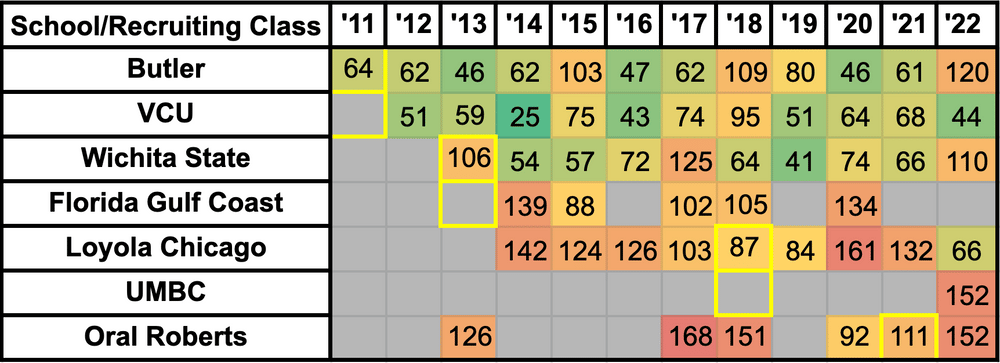
Given the college basketball calendar, where the season ends in early April and the first incoming freshmen will arrive on campus within a couple months, programs are probably unlikely to see an immediate boost in recruiting in a matter of months in the same calendar year. But in the admittedly limited data set above, there appears to be a noticeable, albeit short-lived and inconsistent improvement in a program's recruiting class ranking after a Cinderella run. It will be interesting to see how this data changes, if at all, with more data in the era of immediate eligibility for first-time transfers.
Let's talk finances
Given that many schools that go on Cinderella runs in the men's basketball tournament are private institutions, including three of the seven I examined, it can be a challenge to paint a complete picture of an athletic department's finances after a tournament run. But by using the U.S. Department of Education's Equity in Athletics Data Analysis (EADA) resources, some financial information is available, even for private institutions.
I found that on average, the schools examined saw their total athletic department revenue increase by an average of 17.2 percent, year over year, in the year of their respective NCAA tournament runs. For the total time period examined — every fiscal year from 2010 through 2020 — the average year-over-year increase in revenue was 7.1 percent, suggesting there could be some level of immediate boost in revenue due to a Cinderella run.
Some of the largest single year-over-year increases in revenue came in a school's first fiscal year in a new conference, including Butler's transition from the Horizon League to the A-10 (27.0%), Wichita State's move from the Missouri Valley to the AAC (22.5%) and VCU's switch from the CAA to A-10 (16.0%).
It was those moves that helped Butler's annual revenue increase by 142 percent, or roughly 2.5 times, from 2010 to 2020, and VCU's annual revenue to double during that span. They joined conferences that typically earn more NCAA tournament bids than their previous conferences, which if nothing else, raises the floor for each men's basketball program and athletic department, and could improve ticket sales, concessions and contributions due to a stronger home schedule.
Below shows a year-by-year breakdown of Wichita State and Florida Gulf Coast's men's basketball expenses, ticket sales and contributions for every fiscal year since 2010, with the fiscal year of each program's Cinderella NCAA tournament run outlined in yellow.
Florida Gulf Coast experienced an immediate and significant increase in ticket sales — a revenue source that has generally maintained levels of more than a half-million dollars per year, the last two seasons excluded — and the program's expenses have also maintained at a level of roughly $400,000 to $800,000 more per year compared to prior to its 2013 NCAA Tournament run.
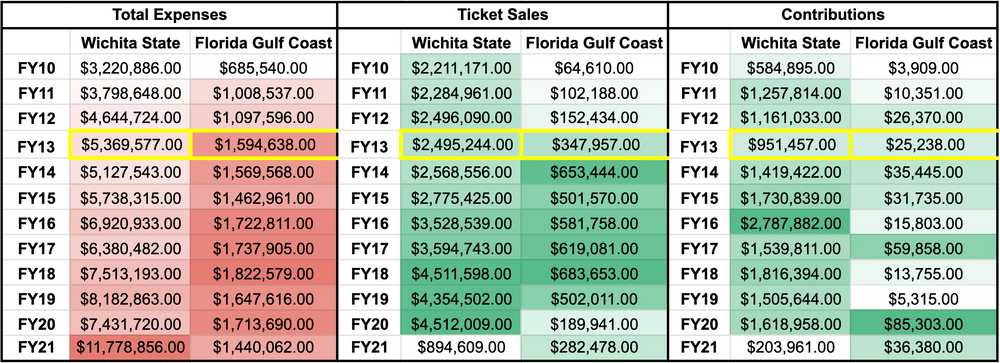
Wichita State and Florida Gulf Coast's trends in men's basketball program expenses, ticket sales and contributions, based on their NCAA Membership Financial Reporting System reports.
Here are Florida Gulf Coast and VCU's trends in admissions since their Cinderella runs
Extra Points obtained Florida Gulf Coast University's admissions numbers through a public records request and found that in 2014, the first full admissions cycle following the men's basketball program's Sweet 16 run in 2013, the number of applications to the university increased by 27.4 percent year over year, while the admission rate fell by nearly seven percentage points, as the number of enrollees stayed roughly the same. Ever since, the university's number of applicants has more or less maintained an annual level of between 13,500 and 15,500 applicants, whereas that number just barely cracked 10,000 prior to its men's basketball program's March Madness run.
The dotted line in the table below separates the final applicant class before the Sweet 16 run and the class that enrolled just months after it, with the major jump in applicants occurring in the first full, post-Sweet 16 admissions cycle in 2014.
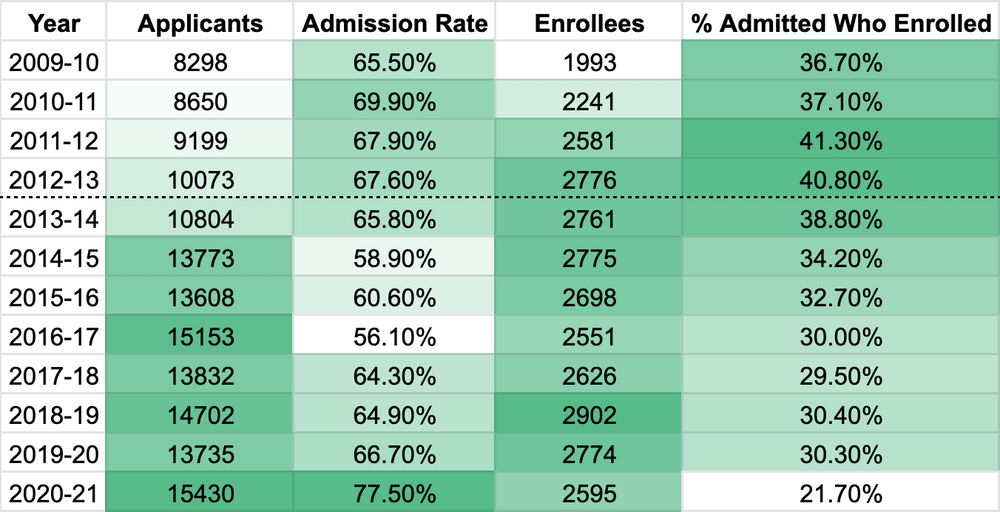
Florida Gulf Coast has always been located somewhere that many high schoolers would find appealing. It may have just taken a week and a half of newfound national media exposure on channels such as CBS, TNT and truTV for them to learn that such a school existed. When you hear dollar figures thrown around about how much exposure or earned media Saint Peter's will receive from this year's tournament run, remember that those "dollars" can't be spent to build a new basketball practice facility, dorms or academic buildings on campus. The admissions office and the school's often outbound head coach might be the biggest beneficiaries.
Below is VCU's admissions data for first-time, first-year students and among the years examined, the university received the fewest number of applications in the academic year (2010-11) and calendar year (2011-12) of its men's basketball program's Final Four run. While the university's first full freshman class after the tournament run — the 2012-13 freshman class — saw nearly a 10-percent, year-over-year increase in applicants, the university had already received more applicants than that in the late aughts, making it a challenge to attribute the increase solely to the Rams' men's basketball success.
Today, VCU receives roughly the same number of applicants it did in 2008, only its admission rate has skyrocketed despite its number of enrollees only marginally increasing from a decade ago. However, the pandemic may be primarily responsible for smaller freshman classes in the last two years.
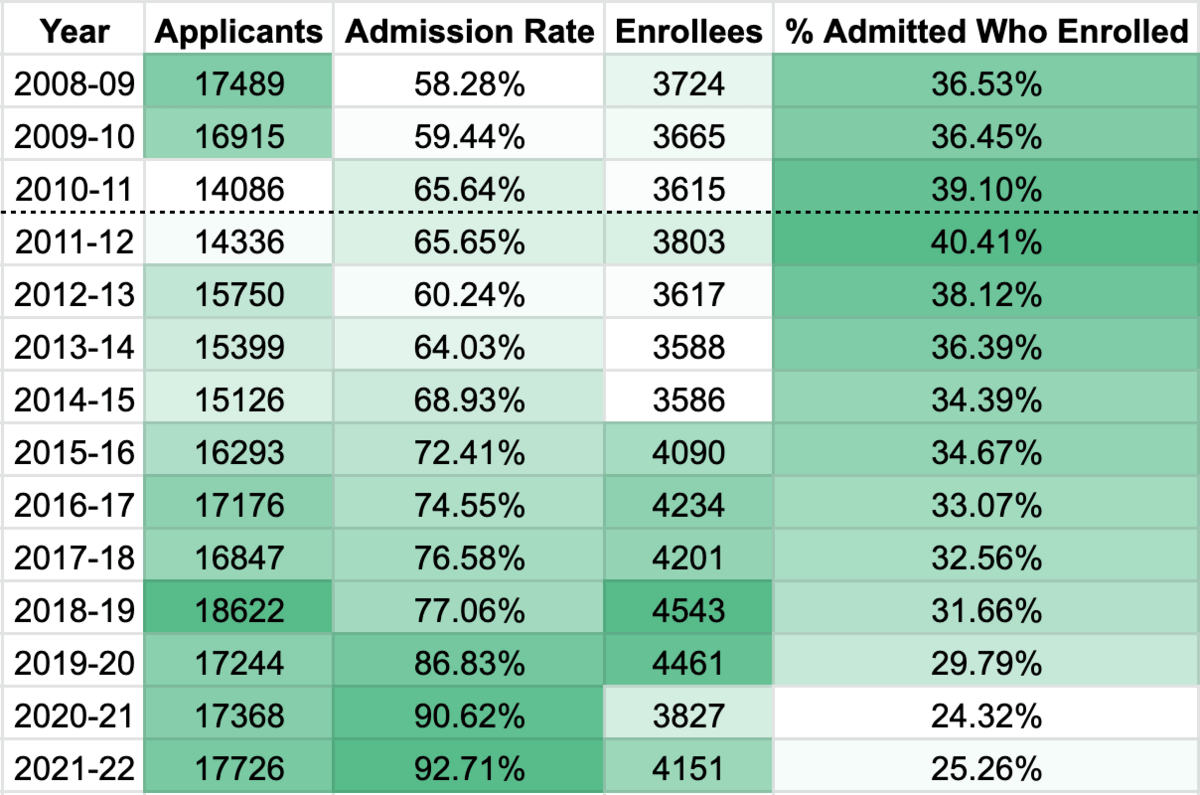
Given that the 2020 undergraduate enrollment of Saint Peter's was roughly 2,300 students, with an admission rate of roughly 85 percent, per U.S. News & World Report, it won't be a surprise to see the university see a notable increase in applicants on a percentage basis for the 2023-24 academic year or for the university to become slightly more selective through a likely-to-decrease admission rate, perhaps more akin to Florida Gulf Coast than VCU.
But as a small, private, Jesuit institution across the river from Manhattan, the university might only be attractive to a certain profile of high school students, potentially limiting any applicant boom.
Okay, so Tl;dr, what should we make of this?
The good news is, there certainly appears to be data suggesting short term boosts in revenue, recruiting, applications and other metrics, right after a big Cinderella run. That matches with much of the existing research on the Flutie effect.
Sustaining success on the court is much harder, although not impossible. Deep March runs often mean coaching changes, and at the mid and low-major levels, we're looking at schools that don't often have huge budgets. For schools that were able to string multiple March wins together, like Butler, VCU, George Mason and Loyola Chicago, new conference invitations, new donors and new money helped raise the floor of the program, although Butler and George Mason's current performance shows that past success is no guarantee of future results.
Building a dynasty at a place like UMBC, Florida Gulf Coast or Saint Peter's is really hard.
But hey, even if that doesn't happen, nobody can take away that One Shining Moment, right?
That's pretty fun, too.
If you enjoy Extra Points, please consider sharing it with your friends and colleagues. Better yet, consider upgrading to a full subscription. EP Subscribers get FIVE newsletters a week, two podcasts, free stickers, access to our Discord server, and the joy that comes from supporting independent media.
This Extra Points newsletter is also brought to you in part by Morning Brew.

There's a reason over 2.6 million people start their day with Morning Brew— the daily email that delivers the latest news from Wall Street to SiliconValley, to Extra Points publisher Matt Brown. Business news doesn't have to be dry and dense...make your mornings more enjoyable, for free.
(Extra Points earns a small commission for each click on that link)
To sponsor a future Extra Points newsletter, please email [email protected]. For article ideas, newsletter feedback, FOIA tips, athlete NIL sponsorships and more, I'm at [email protected], or @MattBrownEP on Twitter. Andy can be reached at @AndyWittry on Twitter or at [email protected]. Extra Points can be found on Reddit at /r/extrapointsmb




